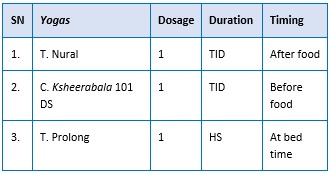Role of Ayurveda in rehabilitation of Abhighataja Pakshavadha - A Clinical Management
DOI:
https://doi.org/10.21760/jaims.8.11.27Keywords:
Hemiplegia, Pakshavadha, Panchakarma, Rehabilitation, ShamanoushadhisAbstract
Traumatic cerebral haemorrhage is an increasingly recognized complication of severe blunt head or neck trauma, more common with patient with motor vehicle accidents, which may lead to complete paralysis, paraplegia, hemiplegia or severe conditions end up with coma. In the present case history, a 43 year aged male patient was in coma stage after he met with RTA and he recovered back with right hemiplegia. So, he was brought for Rehabilitation through Ayurvedic lines of management. Hence for the same, assessments were done through CNS examinations and NIH scoring was adopted to compare the effect before and after the treatment. And specific treatment was planned which includes Panchakarma, diet regimen, Physiotherapy, Shamanoushadhis and was successfully treated with Ayurveda interventions with reference to Pakshavadha line of management as a rehabilitative management and significant results were obtained after 3 follow ups (total duration for 112 days).
Downloads
References
Harrison's Principles of Internal Medicine. 19th ed. Volume 2, Chapter 446. New York: McGraw-Hill Education; 2015. p. 2559-2770.
Acharya JT. Charaka Samhita Sutra Sthana. Varanasi: Chaukhamba Krishnadas Academy; 2016. Sutra 20/11. p. 300.
Acharya JT, Acharya NM. Sushruta Samhita Sutra Sthana. Varanasi: Chaukhambha Surbharati Prakashan; 2011. Sutra 14/30. p. 65.
Acharya JT. Charaka Samhita Sutra Sthana. Varanasi: Chaukhamba Krishnadas Academy; 2016. Sutra 11/45. p. 178.
Acharya JT. Charaka Samhita Sutra Sthana. Varanasi: Chaukhamba Krishnadas Academy; 2016. Sutra 11/45. p. 179.
Acharya JT, Acharya NM. Sushruta Samhita Chikitsa Sthana. Varanasi: Chaukhambha Surbharati Prakashan; 2011. Sthana 5/19. p. 428.
Mishra S (Prof), Govindadas Sen KS (Kaviraj). Baishajya Ratnavali. Varanasi: Chaukhamba Surabharathi Prakashan; 2009. p. 516-526.
Ayurveda Sara Sangraha (Hindi). Shri Baidyanath Ayurved Bhavan Pvt Ltd; 2014. p. 647-657.
Vaidyanath R, Nishteshwar K, Acharya Sharangadhara. Sharangadhara Samhita. Varanasi: Chaukhambha Surbharati Prakashan; 2021. p. 119-123.
Ghoshan V, Mundugaru R, Prakash N, Bhat S, Basavaiah R. Evaluation of neuro-protective activity of Brihat Vata Chintamani Rasa. JPHYTO. 2015;4(4):207-211.
Park SI, Lee EH, Kim SR, Jang YP. Anti-apoptotic effects of Curcuma longa L. extract and its curcuminoids against blue light-induced cytotoxicity in A2E-laden human retinal pigment epithelial cells. J Pharm Pharmacol. 2017 Mar;69(3):334-340.
Rejitha S, Prathibha P, Madambath I. The Ayurvedic drug Ksheerabala (101) ameliorates alcohol-induced neurotoxicity by down-regulating the expression of transcription factor (NFkB) in rat brain. Ayu. 2015 Jul-Sep;36(3):323-328.
Sharma S. Ashtanga Sangraha with Sasilekha commentary of Indu. 2nd ed. Varanasi: Chaukambha Sanskrit Series Office; 2008. p. 144.
Dhanwantari Nighantu by J.K. Ojha, U.P. Mishra. Edition: 2004. Varanasi: Chaukhambha Subharati Prakashana; p. 25-26.
Nagaranjan M, Kuruvilla GR, Kumar KS, Venkatasubramanian P. Pharmacology of Ativisha, Musta and their substitutes. J Ayurveda Integr Med. 2015 Apr-Jun;6(2):121-133.
Mishra S (Prof), Govindadas Sen KS (Kaviraj). Baishajya Ratnavali. Varanasi: Chaukhamba Surabharathi Prakashan; 2009. p. 569-572.















